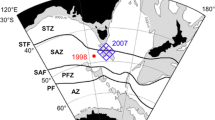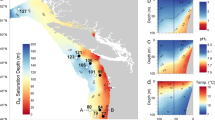Abstract
Pteropods have been a key focus of ocean acidification studies during the last decade due to their fragile aragonite shells and key role they play in polar ecosystems. Pteropods collected at sea are typically preserved before analysis at onshore laboratories. Despite the importance placed on pteropods as a sentinel for the impact of ocean acidification on marine calcifiers, there has never been a systematic study assessing how different preservation techniques affect the condition of pteropod shells. In this study we perform an experiment to assess the impact of six preservation techniques on the shell condition of Limacina retroversa pteropods. Using five shell condition-assessment methods, we find shells that were air dried were the least altered relative to the time of collection. Of the solution-based preservation techniques, shells were least altered when preserved in 70% buffered ethanol and most altered in a solution of sodium chloride buffered formalin. Our results have implications for the interpretation of pteropod shell condition in samples which have been stored in solution, and provide guidelines for the preservation of future pteropod collections.





Similar content being viewed by others
References
Almogi-Labin A, Luz B, Duplessy J-C (1986) Quaternary paleo-oceanography, pteropod preservation and stable-isotope record of the Red Sea. Palaeogeogr Palaeoclimatol Palaeoecol 57:195–211
Bathmann UV, Noji TT, von Bodungen B (1991) Sedimentation of pteropods in the Norwegian Sea in autumn. Deep Res 38:1341–1360
Bednaršek N, Tarling GA, Bakker DCE et al (2012a) Extensive dissolution of live pteropods in the Southern Ocean. Nat Geosci 5:1–5. https://doi.org/10.1038/ngeo1635
Bednaršek N, Tarling GA, Bakker DC et al (2012b) Description and quantification of pteropod shell dissolution: a sensitive bioindicator of ocean acidification. Glob Change Biol 18:2378–2388. https://doi.org/10.1111/j.1365-2486.2012.02668.x
Bednaršek N, Tarling GA, Fielding S, Bakker DCE (2012c) Population dynamics and biogeochemical significance of Limacina helicina antarctica in the Scotia Sea (Southern Ocean). Deep Res Part II Top Stud Oceanogr 59–60:105–116. https://doi.org/10.1016/j.dsr2.2011.08.003
Bednaršek N, Feely RA, Reum JCP et al (2014a) Limacina helicina shell dissolution as an indicator of declining habitat suitability owing to ocean acidification in the California Current Ecosystem. Proc R Soc B 281:20140123. https://doi.org/10.1098/rspb.2014.0123
Bednaršek N, Tarling GA, Bakker DCE et al (2014b) Dissolution dominating calcification process in polar pteropods close to the point of aragonite undersaturation. PLoS ONE. https://doi.org/10.1371/journal.pone.0109183
Bednaršek N, Klinger T, Harvey CJ et al (2017) New ocean, new needs: Application of pteropod shell dissolution as a biological indicator for marine resource management. Ecol Indic 76:240–244. https://doi.org/10.1016/j.ecolind.2017.01.025
Bergan AJ, Lawson GL, Maas AE, Wang ZA (2017) The effect of elevated carbon dioxide on the sinking and swimming of the shelled pteropod Limacina retroversa. ICES J Mar Sci. https://doi.org/10.1093/icesjms/fsx008
Busch DS, Maher M, Thibodeau P, McElhany P (2014) Shell condition and survival of Puget Sound pteropods are impaired by ocean acidification conditions. PLoS ONE. https://doi.org/10.1371/journal.pone.0105884
Collier R, Dymond J, Honjo S et al (2000) The vertical flux of biogenic and lithogenic material in the Ross Sea: moored sediment trap observations 1996–1998. Deep Sea Res Part II 47:3491–3520
Comeau S, Gorsky G, Jeffree R et al (2009) Impact of ocean acidification on a key Arctic pelagic mollusc (Limacina helicina). Biogeosciences 6:1877–1882
Comeau S, Jeffree R, Teyssié J-L, Gattuso J-P (2010a) Response of the Arctic pteropod Limacina helicina to projected future environmental conditions. PLoS ONE 5:e11362. https://doi.org/10.1371/journal.pone.0011362
Comeau S, Gorsky G, Alliouane S, Gattuso J-P (2010b) Larvae of the pteropod Cavolinia inflexa exposed to aragonite undersaturation are viable but shell-less. Mar Biol 157:2341–2345. https://doi.org/10.1007/s00227-010-1493-6
Comeau S, Alliouane S, Gattuso J (2012) Effects of ocean acidification on overwintering juvenile Arctic pteropods Limacina helicina. Mar Ecol Prog Ser 456:279–284. https://doi.org/10.3354/meps09696
Doney SC, Balch WM, Fabry VJ, Feely RA (2009) Ocean acidification: a critical emerging problem for the ocean sciences. Oceanography 22:16–25. https://doi.org/10.5670/oceanog.2009.93
Fabry V, McClintock J, Mathis J, Grebmeier J (2009) Ocean acidification at high latitudes: the bellwether. Oceanography 22:160–171. https://doi.org/10.5670/oceanog.2009.105
Gardner J, Manno C, Bakker DCE et al (2018) Southern Ocean pteropods at risk from ocean warming and acidification. Mar Biol. https://doi.org/10.1007/s00227-017-3261-3
Gerhardt S, Henrich R (2001) Shell preservation of Limacina inflata (Pteropoda) in surface sediments from the Central and South Atlantic Ocean: a new proxy to determine the aragonite saturation state of water masses. Deep Res I 48:2051–2071
Gerhardt S, Groth H, Rühlemann C, Henrich R (2000) Aragonite preservation in late quaternary sediment cores on the Brazilian Continental Slope: implications for intermediate water circulation. Int J Earth Sci 88:607–618. https://doi.org/10.1007/s005310050291
Howes EL, Eagle RA, Gattuso J, Bijma J (2017) Comparison of mediterranean pteropod shell biometrics and ultrastructure from historical (1910 and 1921) and present day (2012) samples provides baseline for monitoring effects of global change. PLoS ONE 1:1–23. https://doi.org/10.1594/PANGAEA.869200
Just J, Kristensen RM, Olesen J (2014) Dendrogramma, new genus, with two new non-bilaterian species from the marine bathyal of Southeastern Australia (animalia, metazoa incertae sedis)—with similarities to some medusoids from the Precambrian Ediacara. PLoS ONE 9:1–11. https://doi.org/10.1371/journal.pone.0102976
Lee C, Cronin C (1984) Particulate amino acids in the sea: effects of primary productivity and biological decomposition. J Mar Res 42:1075–1097. https://doi.org/10.1357/002224084788520710
Lischka S, Riebesell U (2012) Synergistic effects of ocean acidification and warming on overwintering pteropods in the Arctic. Glob Chang Biol 18:3517–3528. https://doi.org/10.1111/gcb.12020
Lischka S, Büdenbender J, Boxhammer T, Riebesell U (2011) Impact of ocean acidification and elevated temperatures on early juveniles of the polar shelled pteropod Limacina helicina: mortality, shell degradation, and shell growth. Biogeosciences 8:919–932. https://doi.org/10.5194/bg-8-919-2011
Manno C, Sandrini S, Tositti L, Accornero A (2007) First stages of degradation of Limacina helicina shells observed above the aragonite chemical lysocline in Terra Nova Bay (Antarctica). J Mar Syst 68:91–102. https://doi.org/10.1016/j.jmarsys.2006.11.002
Meinecke G, Wefer G (1990) Seasonal pteropod sedimentation in the Norwegian Sea. Palaeogeogr Palaeoclimatol Palaeoecol 79:129–147. https://doi.org/10.1016/0031-0182(90)90109-K
Mohan R, Verma K, Mergulhao LP et al (2006) Seasonal variation of pteropods from the Western Arabian Sea sediment trap. Geo-Marine Lett 26:265–273. https://doi.org/10.1007/s00367-006-0035-1
Mucci A (1983) The solubility of calcite and aragonite in seawater at various salinities, temperatures, and one atmosphere total pressure. Am J Sci 283:780–799
Peck VL, Tarling GA, Manno C et al (2016) Outer organic layer and internal repair mechanism protects pteropod Limacina helicina from ocean acidification. Deep Res Part II Top Stud Oceanogr 127:41–52. https://doi.org/10.1016/j.dsr2.2015.12.005
Roberts D, Howard WR, Roberts JL et al (2014) Diverse trends in shell weight of three Southern Ocean pteropod taxa collected with Polar Frontal Zone sediment traps from 1997 to 2007. Polar Biol 37:1445–1458. https://doi.org/10.1007/s00300-014-1534-6
Seibel BA, Maas AE, Dierssen HM (2012) Energetic Plasticity underlies a variable response to ocean acidification in the pteropod Limacina helicina antarctica. PLoS ONE 7:e30464. https://doi.org/10.1371/journal.pone.0030464
Singh AD, Conan SMH (2008) Aragonite pteropod flux to the Somali Basin, NW Arabian Sea. Deep Res Part I Oceanogr Res Pap 55:661–669. https://doi.org/10.1016/j.dsr.2008.02.008
Acknowledgements
The authors would like to thank G. Stowasser, and the crew and scientists of JR15002 for help in collecting the samples. The authors offer their thanks to J. Gardner for her assistance in pteropod picking and for discussions on the cruise. The authors thank P. Wilf for allowing use of the microscope in the Paleobotany Laboratory; and J. Anderson and W. Auker at the Material Characterization Laboratory for their help with the SEM. The authors are extremely grateful to K. Jones-Williams for ranking the shells, and to the three anonymous reviewers whose comments greatly improved this manuscript. RLO received funding from the Hiroshi and Koya Ohmoto Graduate Student Fellowship. RLO and TJB received funding from the Deike Research Grant.
Author information
Authors and Affiliations
Corresponding author
Ethics declarations
Conflict of interest
This is an original submission. There are no conflicts of interest for any of the authors.
Ethical approval
All applicable national and international guidelines for the care and use of animals were followed. Research was conducted in line with the Research Ethics Policy of the Pennsylvania State University.
Electronic supplementary material
Below is the link to the electronic supplementary material.
Rights and permissions
About this article
Cite this article
Oakes, R.L., Peck, V.L., Manno, C. et al. Impact of preservation techniques on pteropod shell condition. Polar Biol 42, 257–269 (2019). https://doi.org/10.1007/s00300-018-2419-x
Received:
Revised:
Accepted:
Published:
Issue Date:
DOI: https://doi.org/10.1007/s00300-018-2419-x




